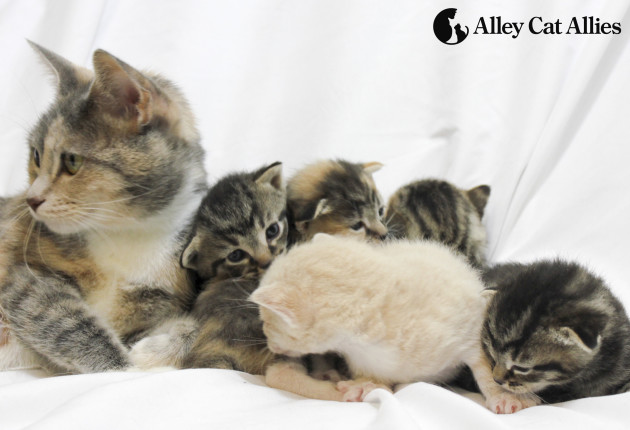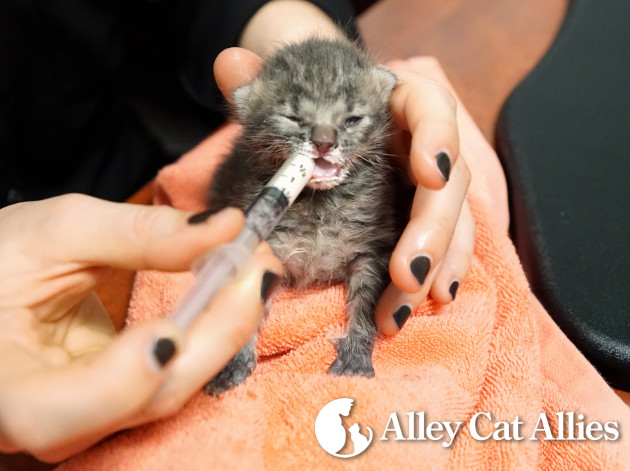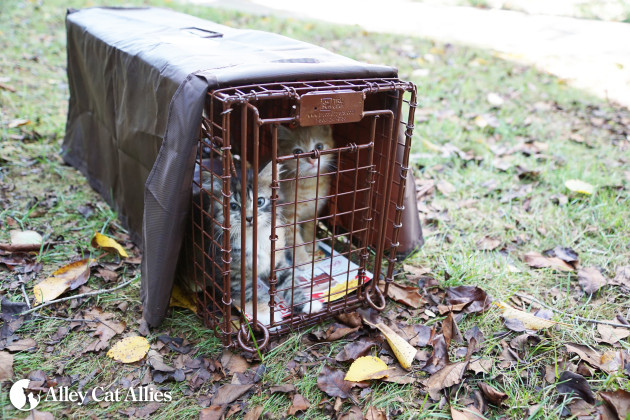“Kitten season” – that time of year when babies are born to cats who have not been spayed or neutered resulting in millions of unwanted kittens. Too many end up in shelters and never leave. So, what can we do to help these kittens? Do we leave them alone outdoors or bring them inside our homes?
According to Alley Cat Allies, there are five easy ways people can help cats and kittens this spring. Becky Robsinson, president/founder of Alley Cat Allies says one must carefully consider what to do with them based on the “individual kitten’s situation and age.”
Tip #1: Leave kittens with mom.
Like all babies, kittens are best left with their mothers who instinctively know how to help their offspring grow up to be strong and healthy cats. Neonatal kittens, four weeks old or younger, need around the clock attention and depend on mom for 100 percent of their care. Kittens five to eight weeks old can begin to eat wet food but are still being weaned. (To determine the age of a kitten, use Alley Cat Allies’ Kitten Progression Guide at www.alleycat.org/KittenProgression.)
If you know the mother is present, it is best to leave kittens with her. To determine whether the mother is caring for the kittens, wait and observe for two to four hours to see if the mother returns. She could just be out looking for food. If she doesn’t return, the kittens could be abandoned. A young kitten living outdoors who does not have a mother present should be taken in and fostered.
If you are unsure, Alley Cat Allies has a number of resources available to help. The Alley Cat Allies’ National Cat Help Desk can provide advice and direction for a number of situations. Another option is the Alley Cat Allies’ Feral Friends Network – local individuals and organizations that may be able to help with hands-on advice, information about borrowing equipment, and veterinarians or clinics that can spay and neuter feral cats. To request a list of Feral Friends in your area, visit www.alleycat.org/FeralFriends.
Tip #2: Don’t bring neonatal kittens to an animal shelter.
Most shelters are not equipped or trained to provide the necessary round-the-clock care for neonatal kittens. If a kitten can’t eat on her own, she will likely be killed at the shelter. Realistically, it’s never a good idea to take a cat to a shelter, no matter the age or level of socialization. There are some shelters who have lifesaving programs for cats, but across the nation, more than 70 percent of cats who enter shelters are killed. That number rises to virtually 100 percent for feral cats. Killing is never the answer—it is inhumane and it fails to stabilize or reduce outdoor cat populations.
Tip #3: Volunteer as a kitten foster parent for a local rescue group.
There are kitten foster parent programs across the country. Though it is an investment of time and requires training, volunteering to foster young kittens is lifesaving and rewarding. To learn the basics of kitten care, register for Alley Cat Allies’ free “Help! I found a kitten!” webinar at www.alleycat.org/KittenWebinar.
Tip #4: Support and practice Trap-Neuter-Return (TNR).
TNR is the only effective and humane way of stabilizing and reducing community cat populations. In a TNR program, community cats are humanely trapped and brought to a veterinarian to be spayed or neutered, vaccinated, and eartipped (the universal symbol that a cat has been neutered and vaccinated) before being returned to their outdoor homes. Learn more about TNR at www.alleycat.org/TNR.
Spaying and neutering community cats prevents new litters, drastically reducing the impact of kitten season. Cats as young as four months can have litters, so it is important to spay and neuter kittens as soon as they are ready. A good rule of thumb is the 2 Pound Spay/Neuter Rule – kittens can be safely spayed or neutered at two months of age or as soon as they weigh two pounds. Learn more about pediatric spay and neuter at www.alleycat.org/spayneuter.
Tip #5: Advocate for policies and programs that protect cats.
Contact your shelter and local officials and tell them you support lifesaving policies for cats, including spay and neuter funding and spay and neuter before adoption. Write letters and call in support of community outreach and education programs that spread awareness about spay and neuter, community cats and TNR – you can make a big difference. Learn how you can help your local shelter save more cats’ lives atwww.alleycat.org/HelpShelters.
Have a story, please email me at tevangelistaepp@yahoo. Like my tv page at https://www.facebook.com/ACloseUpLookAtAnimalWelfareIssues.




I don’t want cats in my backyard. TNR doesn’t stop them from defecating in my flower bed.
I’m impressed, I must say. Really rarely do I encounter a blog that’s both educational and informative. The five tips are important but keeping cats indoors would solve this problem completely. Always spay and neuter your cats.
Stop putting your cats outside where they continually procreate and create more problems. Too many cats die in shelters. There aren’t enough people willing to adopt them. Be responsible!!
I agree with what you said. I wish people would keep their cats indoors. Letting them out for just a little bit can cause major problems. The majority of cats living outside are as a direct result of people no longer caring about their cats. Leave them out and let them fend for themselves. The cats become feral and then you have kittens. If they aren’t saved from living on the streets, they, too, become feral and pregnant creating more kittens. The vicious cycle never ends and that is why there are so many. When I see kids running around without parental supervision, why would I expect them to care about cats? The feral cats present problems. They don’t mean to but it happens. Everyone else is supposed to clean up after those who don’t. I’m tired of this throwaway society especially when it comes to our pets!
Shared.
Good tips.
I dread this time of year. People take mothers and kittens to shelters thinking they will get a home when the harsh and cruel reality is that most are euthanized. Most never get a chance at life. They were born to die in only a few weeks. It’s awful. Its heartbreaking. I wish shelters would be honest with the public. I’m not putting the blame on them. They are only cleaning up other people’s messes but at least tell them the vast majority of cats and kittens lost their lives once you surrender them. Too sad for me. :'(
awww
Owners of cats need to step up to the plate and be responsible. I’m now seeing feral cats in my backyard and some are downright nasty. I don’t blame them but they cause a lot of problems. It’s so unfair to them. If you take them to a shelter, they’re going to be killed. If you feed them, you will have more in your yard. I don’t want any cats in my yards. I don’t hate them. I feel bad for them. I wish their owners would keep them inside. If they live in the country, I believe that’s a different story. In suburban areas and cities, it’s a mess with them. If you’re not going to keep your cat indoors, don’t get any.
I caught three cats in the last week in a humane trap. One was feral and two were pets. I released the two pet cats and took the feral to a more rural area and released. I didn’t want to take it to a shelter where I know they would kill it as soon as I would leave. He was extremely nasty. It’s not his fault he’s feral and I didn’t want him to pay the price for what his owners did to him. Owners have to SPAY and NEUTER their cats and keep them indoors!!! They’re better all the way around. Why are people so stupid?
Very beneficial… look forward to coming back
Spay and neuter your cats. Keep them inside. Don’t discard them outside. Get them microchipped.
Keep you spayed/neutured cat indoors! It’s a no-brainer!